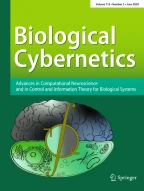Abstract
For the control of the movement of a multijoint manipulator a “mental model” which represents the geometrical properties of the arm may prove helpful. Using this model the direct and the inverse kinematic problem could be solved. Here we propose such a model which is based on a recurrent network. It is realized for the example of a three-joint manipulator working in a two-dimensional plane, i.e., for a manipulator with one extra degree of freedom. The system computes the complete set of variables, in our example the three joint angles and the two work-space coordinates of the endpoint of the manipulator. The system finds a stable state and a geometrically correct solution even if only a part of these state variables is given. Thus, the direct and the inverse kinematic problem as well as any mixed problem, including the underconstrained case, can be solved by the network.
Similar content being viewed by others
References
Cruse H (1986) Constraints for joint angle control of the human arm. Biol Cybern 54:125–132
Hinton G (1984) Parallel computations for controlling an arm. J Motor Behav 16:171–194
Hollerbach JM, Atkeson CG (1987) Deducing planning variables from experimental arm trajectories. Pitfalls and possibilities. Biol Cybern 56:279–292
Hopfield JJ (1984) Neurons with graded response have collective computational properties like those of two-state neurons. Proc Natl Acad Sci USA 81:3088–3092
Morasso P, Sanguineti V (1991) Neurocomputing concepts in motor control. In: Paillard J (ed) Brain and space. Oxford University Press, Oxford, pp 404–432
Morasso P, Mussa Ivaldi FA, Vercelli G, Zaccaria R (1989) A connectionist formulation of motor planning. In: Pfeifer R, Schreter Z, Fogelman-Soulie F, Steels L (eds) Connectionism in perspective, Elsevier, Amsterdam, pp 413–420
Mussa Ivalid FA, Morasso P, Zaccaria R (1988) Kinematic networks — a distributed model for representing and regularizing motor redundancy. Biol Cybern 60:1–16
Author information
Authors and Affiliations
Rights and permissions
About this article
Cite this article
Cruse, H., Steinkühler, U. Solution of the direct and inverse kinematic problems by a common algorithm based on the mean of multiple computations. Biol. Cybern. 69, 345–351 (1993). https://doi.org/10.1007/BF00203131
Received:
Accepted:
Issue Date:
DOI: https://doi.org/10.1007/BF00203131
